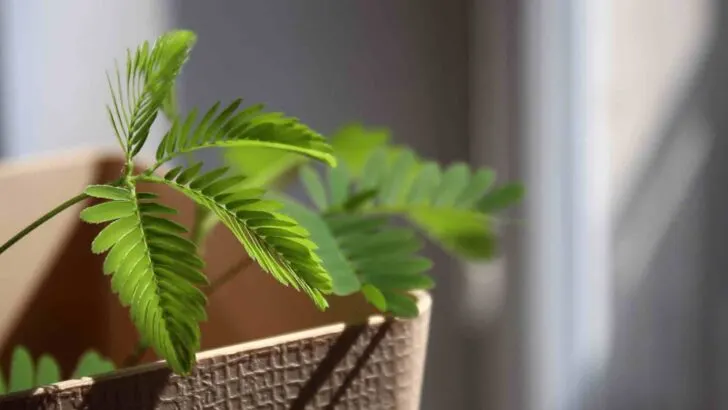Mimosa pudica, aka the Sensitive plant or touch me not plant, belongs to the Leguminosae family and is the only one of about 500 species cultivated as an indoor plant.
Mimosa pudica is native to the (sub-)tropical part of the American continent and is particularly popular as an indoor plant because of its reaction to mechanical stimuli: When touched, the pinnate leaves collapse within about one second. But not only that, the entire leaf with the already folded pinnate leaves folds downwards. Truly spectacular!
How to best care for the plant and what secrets lie behind this mysterious reaction of the plant when touched can be discovered in this exciting article.
Well, let’s get started!

Table of Contents
Mimosa Pudica Plant Care Basics
Soil: Since Mimosa pudica is an annual plant, meaning you will most likely only have this plant in your home for a short period of time, you do not need to spend A Standard houseplant potting soil will do the trick and will keep your plant happy (at least as far as your choice of soil goes).
Light: When it comes to light, the Mimosa Pudica tolerates a lot. Mimosa pudica is native to the tropical regions of America. It is, therefore, no surprise that it likes bright light and can even cope with a portion of direct sunlight. Let the plant thrive in a location with high humidity. The bathroom is usually a suitable place for the Sensitive plant. Avoid exposing your Mimosa to the blazing sun during lunchtime.
Watering: As usual with many indoor plants, Mimosa pudica likes it quite moist. Avoid that the plant dries out completely. Waterlogging, on the other hand, is not good for this leafy friend either.
Temperature: Find a spot that blesses your plant with a temperature of around 20 degrees throughout the day. At night, your Mimosa would preferably want to stay in a location that is slightly colder (around 18 degrees is perfect).
Humidity: Mimosa pudica likes high humidity. Since the humidity in your own four walls is often rather low, it is usually a good idea to mist the leaves of your plant on a regular basis. You can use a hand mister to do so. A humidity tray for your plant is another good way to keep the humidity high.
Fertilizer: Mimosa pudica likes to be fed. Therefore, feel free to pamper your mimosa with nutrients once a week. Liquid fertilizer is most suitable for this purpose. You can simply add the liquid fertilizer to the irrigation water. It is generally a good idea to dilute the fertilizer to half the strength recommended on the label.
Propagation: The most common propagation method for Mimosa pudica is by seed propagation. Propagating the Sensitive plant is considered an easy task.
Growth: Grows up to 1.5 meters in length. As a house plant, however, mimosa rarely grows higher than 50 centimeters.
Potting: Repotting is not something that you will have to deal with often when it comes to Mimosa pudica, as we are dealing with an annual plant here, which essentially means that you will only have this plant for one season. Still, if your Sensitive plant should outgrow the pot, repotting can be a good idea, especially if you should discover that your Mimosa is root-bound (pot-bound). To check that, simply take your plant out of the pot and check if there are lots of roots (the dirtball would be full of roots in this case) and roots would be going all around in circles.
Mimosa pudica propagation
Mimosa pudica is propagated by seed propagation. The propagation of this plant is very easy.
If your plant has been blessing you with seeds, you can use these seeds to propagate. If not, you can easily buy seeds online.
To propagate, just follow these steps:
-
- You can begin propagating by the beginning of march
- The soil should have a temperature of at least 20 degrees
- Choose the number of seeds that you put in one and the same pot according to the size of the pot. It generally makes sense to put at least 3-4 seeds in the same pot to ensure dense growth. If you are using very large pots, you can obviously also place more seeds in it.
Mimosa pudica watering tips
Generally speaking, Mimosa pudica is not a very difficult houseplant to keep and it is considered to be pretty hardy. However, when it comes to watering, Mimosa pudica attaches great importance to an adequate water regimen.
The right water for your Mimosa pudica
Mimosa pudica is not very tolerant of lime and should, therefore, be watered with soft water.
Rainwater is a great choice. Distilled water is also fine. Even tap water is acceptable.
The right amount of water for your Mimosa pudica
Sensitive plants can’t tolerate either stagnant moisture or dry root balls, which is why you should always keep the substrate evenly moist. Before watering again, always check the top layers of the soil with your fingers and only water it when the surface of the substrate is already dry.
As with many other houseplants, Mimosa pudica does not like wet feet. Waterlogging needs to be omitted at all costs.
So you should aim for keeping your Sensitive plant consistently moist, but not soggy.
Common problems exhibited by Mimosa pudica
Problem: Yellow leaves on Mimosa pudica
Cause: Yellow leaves on house plants are very often an indication that something is wrong with the water balance. Yellow leaves on house plants are very often an indication that something is wrong with the water balance. This also applies to Mimosa pudica. As so often, yellow leaves are an indication that your Sensitive plant is getting too much water. The yellow color may initially only be visible at the tips of the small leaves, but can then spread to the whole leaf.
Solution: Decrease the amount of water that your Mimosa is getting.
Problem: Folded leaves no longer open & curl (exhibiting a gray-green color and dry out)
Cause: This is a sign that your plant has suffered cold damage. If you keep the plant outside, for example on the balcony, then it is possible that the temperature during the night or generally the temperature fluctuations have damaged your mimosa.
Solution: If your plant was outside, it may be a good idea to bring the plant inside. Then, inside, ensure that the temperature changes are kept within limits. The transition phase (from outside to inside) is, however, problematic, in itself as the plant is suddenly in a completely different environment and needs some time to adjust.
Problem: Folded leaves, single leaves fall off little by little (+NO yellowing leaves)
Cause: Your plant may be infested with pests.
Solution: Isolate your plant and try to get rid of the pests. Depending on the pest, the method to get rid of them will be different. Mimosa pudica is generally not known as a plant prone to disease, however, it may become infested with either red spider mites or mealybugs, which are two common houseplant pests. Spraying your plant (water spray) can help to get rid of these pests. If you are keeping your Mimosa pudica outside, you might do so with a hoze.
The responsive leaves of Mimosa Pudica
One of the major reasons why Mimosa Pudica is grown by houseplant enthusiasts all over the world is its responsive leaves. What we mean by that is best told with a little video.
So you can see that Mimosa pudica actually gives a nice reaction upon touch.
But why does it even show this shrinking reaction to contact?
There are several theories on why Mimosa pudica reacts in this way. The most plausible ones are that the plant is trying to defend itself from herbivore attack that way. The shrinkage of the leaves makes the leaves smaller and when insects land on the leaves, the shrinkage is likely to make them move away (Amador-Vargas 2014: 1446).
Does Mimosa pudica always show this reaction when touched?
No. Mimosa pudica does not show any reaction upon touch at night.
Moreover, if the temperature falls below 18 degrees, your Sensitive plant will also not be responsive.
Mimosa Pudica FAQ
-
-
What health benefits does Mimosa pudica offer?The health benefits of Mimosa pudica are numerous. Here are some of Mimosa pudicas greatest benefits: Mimosa pudica kills parasites, Mimosa pudica is rich in antioxidants (leaves, stems as well as seeds), it supports wound healing, it helps to combat diarrhea and it is also good for your skin. But please note: Mimosa pudica is not edible for consumption. However, you can find many Mimosa pudica products on the internet.
Do Mimosa pudica also thrive in terrariums?Mimosa pudica can certainly thrive in a terrarium. Since Mimosa pudica generally attaches importance to high humidity and cannot tolerate temperature fluctuations too well, keeping them in a terrarium can be a very good decision.
Is it a good idea to touch your Sensitive plant (all the time)?No, that’s definitely not a good idea. Because every time you touch your plant, it is forced to expend a lot of energy. So it is best to do this only when it is really necessary.
How large can Mimosa pudica get?These plants can grow to a length of about 1.5 meters.
What about the longevity of Sensitive plants?Sensitive plants are generally considered to be annual plants which means that they usually die after one year. However, under certain circumstances, Sensitive plants can also live up to two years.
My Mimosa’s leaves are not responsive. What’s wrong?If your mimosa does not react when touched, this can have various reasons. The two most likely reasons are: The (wrong!) time of day or a too low temperature, because the plant is only touch-sensitive during the day (it rests at night) and if the temperature is below 18 degrees, then Mimosa pudica also shows no reaction upon touch.
Is Mimosa pudica edible?Despite the fact that Mimosa pudica has many different medicinal uses, the plant itself is not edible for consumption. However, Mimosa pudica seeds are indeed edible and you can find numerous Mimosa pudica products on the market. Just type in Mimosa pudica on Amazon and you will find Mimosa pudica seeds, Mimosa pudica in powder form, capsules & much more.

Daniel has been a plant enthusiast for over 20 years. He owns hundreds of houseplants and prepares for the chili growing seasons yearly with great anticipation. His favorite plants are plant species in the Araceae family, such as Monstera, Philodendron, and Anthurium. He also loves gardening and is growing hot peppers, tomatoes, and many more vegetables.
-


